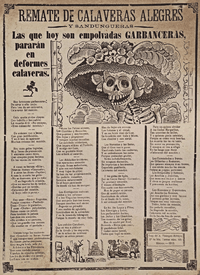Literary Calaverita
The calavera literaria is a Mexican traditional composition in verse. They are often written for the Day of the Dead.[1][2]

Posada's La Calavera Garbancera together with a literary calaverita in 1913
History
Initially known as panteones, these verses had their origin in the 19th century as mocking epitaph and a way of expressing ideas or feelings that in other occasions might be difficult to express.[3][2] For this reason they were often censored or destroyed, since they also often served as a means to express political satire.[3][2] The first calaveras were published in 1879, in the newspaper El Socialista, of Guadalajara.[2]
gollark: Now, imagine that somehow, despite the challenges of getting said nontechnical boss² to do anything, they convince them successfully to remove the procedure or make it easier.
gollark: The boss has some idea of the technical challenges involved. *Their* boss probably doesn't.
gollark: Consider it from a corporate mismanagement perspective though.
gollark: * graph
gollark: Alternatively, add another related element field and make it into a tree.
References
- Argüelles, Juan Domingo (2 November 2003). "La adulteración de las calaveras". La Jornada en línea. Retrieved 10 October 2012.
- González, Carmen (16 October 2008). "Son las calaveras literarias una manifestación de la cultura popular". El Sol de Tlaxcala. Retrieved 10 October 2012.
- Marroquín, Fausto Martínez. ""Calaveritas", una hermosa y casi desaparecida tradición". México desconocido. Retrieved 10 October 2012.
This article is issued from Wikipedia. The text is licensed under Creative Commons - Attribution - Sharealike. Additional terms may apply for the media files.